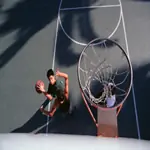Point guards definitely need to know how to use various on-ball screens. Repeating basic pick-and-roll drills from various angles and areas of the basketball court is a great way to develop this competency.
A basic pick-and-roll drill that you can use for this purpose is to give your point guard the ball and have him use a screen (or "pick") set just outside the elbow at the three-point line. He will be guarded, as will the screener. In this four-person drill, the point guard will use the screen/pick to free up for a jump shot or pass to the screener rolling to the hoop.
One key point is for the guard to establish an effective angle to the screen. The correct angle will have him brushing by the screener's shoulder at close to a 45-degree angle. He should not allow any space for his defender to "fight through" the screen. What happens next is determined by how the screener's defender plays the action:
- If the defender switches to cover the dribbler, there is an opportunity for the point guard to deliver a pass to the screener rolling to the hoop. This is a short opportunity. Usually, the pass needs to be made within one dribble of noticing the switch. A bounce pass is often available. Insist on this quick pass, because there will not be time or space in a real game for uncontested lobs.
- If the defender does not switch out to cover the point guard, then he should put up a jump shot as he clears the screen. This is a shot that he should strive to master.
Once the basic pick-and-roll principles are well established, you can integrate it into more realistic game settings. For instance, you can add an offensive player at the opposite block and have him defended, you can allow the defense to overplay the screen, you can add two more defended offensive players, and, finally, you can practice this in a five-on-five context. As you add these elements, you will be instructing all your players, and especially your point guard, on how to use the pick-and-roll to generate good shot opportunities.







Discuss This Article